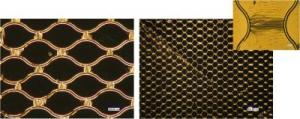Mar 25 2014
Wrinkling is a common phenomenon for thin stiff film adhered on soft substrate. Various wrinkling phenomenon has been reported previously. Wu Dan, Yin Yajun, Xie Huimin,et al from Tsinghua University proposed a new method to control wrinkling and buckling of thin stiff film on soft substrate. It is found that the curve pattern on the soft substrate has obvious influence on the wrinkling distribution of the thin film/soft substrate.
Their work, entitled "Controlling the surface buckling wrinkles by patterning the material system of hard-nano-film/soft-matter-substrate", was published in SCIENCE CHINA Physics, Mechanics & Astronomy 2014, Vol 57(4) issue.
 This image shows a set of S-shaped curves with an opposite phase (aluminum film thickness 200 nm). Credit: ©Science China Press
This image shows a set of S-shaped curves with an opposite phase (aluminum film thickness 200 nm). Credit: ©Science China Press
Wrinkling and buckling at micro-scale are a popular phenomenon in stiff nano-film on compliant substrate due to external stimuli such as thermal mismatch. This feature has many applications in the design and fabrication of flexible electronics and devices, micro-cell arrays, optical gratings, and so on.
Thermal mismatch is one of the important factors which cause the surface buckling of stiff nano-film on compliant substrate. The wrinkling formation mechanism of the stiff film on compliant substrate of Polydimethylsiloxane (PDMS) is illustrated in Figure 1. The PDMS substrate is heated and will be expanded as a result during the deposition of the stiff film. When the deposition is completed, the stiff film is formed on the substrate and the substrate cools down. The contraction of the substrate due to temperature dropping is restricted by the stiff film, for the thermal coefficient of the PDMS substrate is much larger than the stiff film. In accommodating the deformation mismatch between the substrate and the stiff film, interface constraint force is induced consequently. The deformation compatibility causes compressive stress in the stiff film and tensile stress in the compliant PDMS substrate. Once the compressive stress in the stiff film exceeds the critical buckling stress, surface buckling and wrinkling will occur to balance the system.
The wrinkling appears randomly and in disorder in the uniform, continuous and isotropic film under the condition of equally biaxial compressive stress. The orientation ordering of wrinkles induced by isotropic buckling has been studied by simulation method but few works have been reported on how to control the surface wrinkling orientation according to the design specification, which is significant for the design of the flexible electronics. The idea of regulating the orientation and distribution of the wrinkling by patterning the surface of the stiff film/compliant substrate system has been proposed by researchers recently. Various patterns have been designed on the PDMS substrate to control the buckling distribution and orientation. Some progress from recent work has been made in this research.
A photolithography process has been conducted to fabricate the curve patterns on the soft PDMS substrate and then the thin stiff aluminum film is deposited on the soft substrate. A few experimental results have been show in Figure 2 and Figure 3. Through the wrinkling behavior of the thin stiff film/soft substrate by patterning the soft substrate with various curves, the conclusions are summarized: On the concave side of the curve, the wrinkling of the film surface is suppressed to be identified as shielding effect and on the convex side the wrinkling of the film surface is induced to be identified as inductive effect. The shielding and inductive effects make the dis-ordered wrinkling and buckling controllable. This finding may give some new ideas to the designing of the wrinkling pattern of thin stiff film/soft substrate.